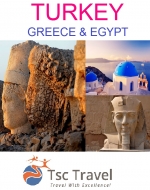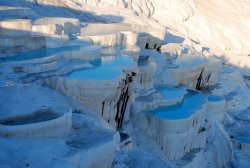PAMUKKALE
Top Spots
In the Denizli province of Turkey, sits the cotton castle. Tumbling down the side of a small mountain, white calcium pools filled with healthy spa water have solidified to form stunning looking travertines in the landscape. From a distance, the white pools look like part of a strategic castle hence the nickname. Along with Ephesus, Pamukkale is one of the top attractions for foreigner tourists visiting the Aegean coast.
People have bathed in the spa water pools for thousands of years. Indeed, the Romans redirected water to the nearby city of Hierapolis as a centre of healing for wounded soldiers. Unfortunately, when travel became more accessible to the masses, hotels were built around the travertine pools and over time, they caused a lot of damage. Cars and motorbikes were also allowed to use pathways running in between the pools.
The inclusion of Pamukkale and the city of Hierapolis to the UNESCO World Heritage Site list ensured the removal of the hotels, a ban on public transport and preservation of the ancient site. It is said that at certain times of the year, when the sun is rising, the white cotton castle turns a soft shade of pink. If you cannot wake up in time to see the sunrise, at least watch the magnificent orange sunset across the plains.
Hierapolis
In ancient Greek, the name Hierapolis meant “holy city.” Founded in the 2nd century BC, as well as being a centre of healing, many people chose to retire or even travel there so it could be their last resting place. Eventually the city was given to the empire of Rome, and along with places like Ephesus, Christianity became strong in the region.
Excavations started in 1887 by a German archaeologist revealed a large city and one of the relics that interested historians was the perfectly preserved large sarcophagi that contained the body of local citizen Marcus Aurelius Ammianos.
Visitors today can view a gymnasium, library, the Domitain gate, and baths that were constructed using just stone and no cement. One of the most respected attractions though is the large amphitheatre. Nestled into the hillside, it is suspected to have been built in AD 60 with a capacity to seat 15,000 spectators. As often seen in other historical sites, there is also a Temple of Apollo
Further Reading
Browse through our sites for articles, news and information about Turkey. More…



